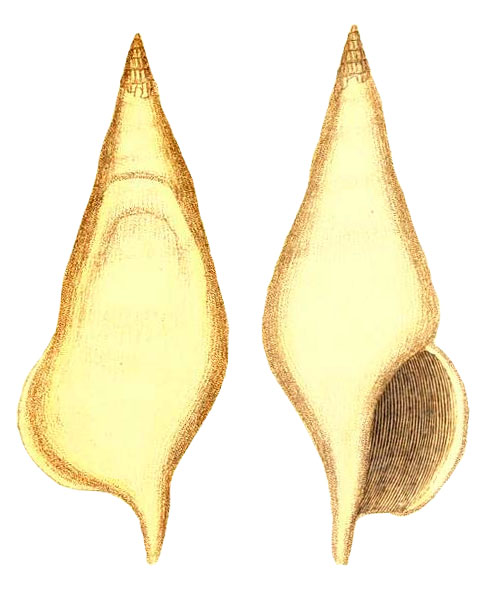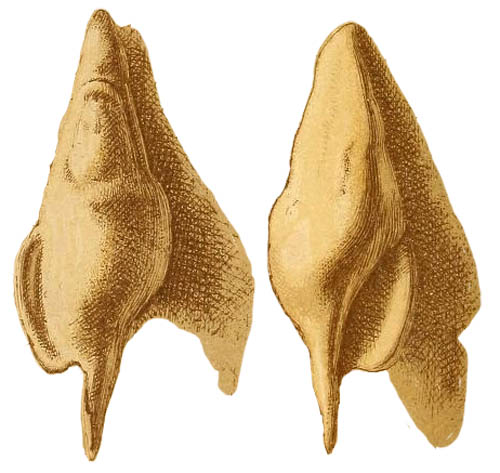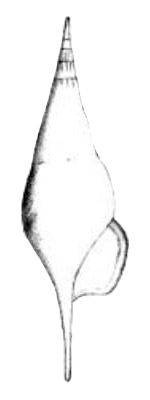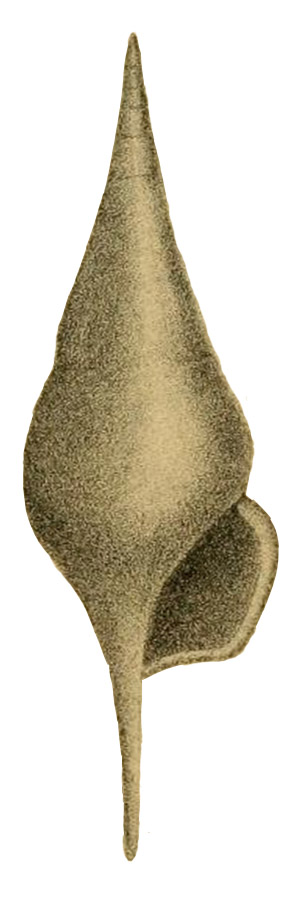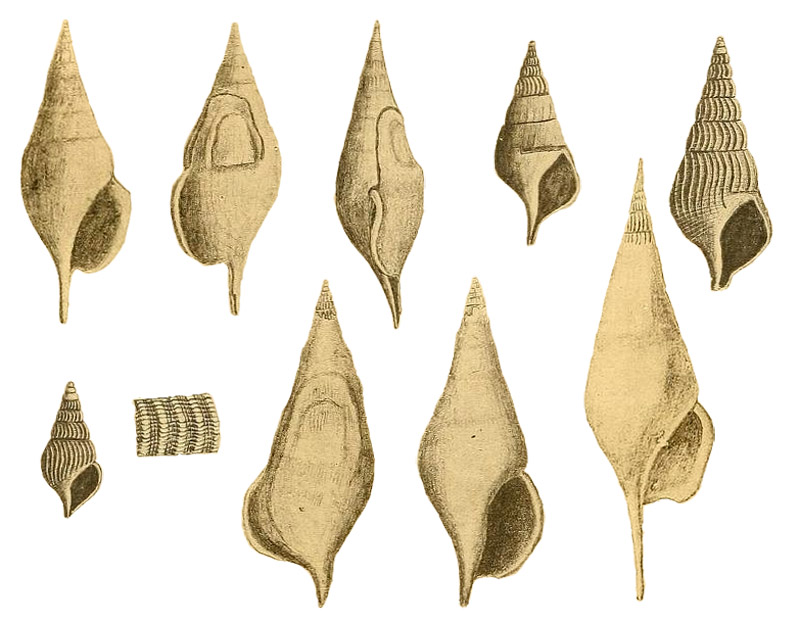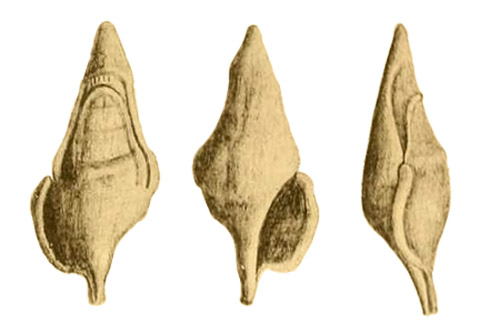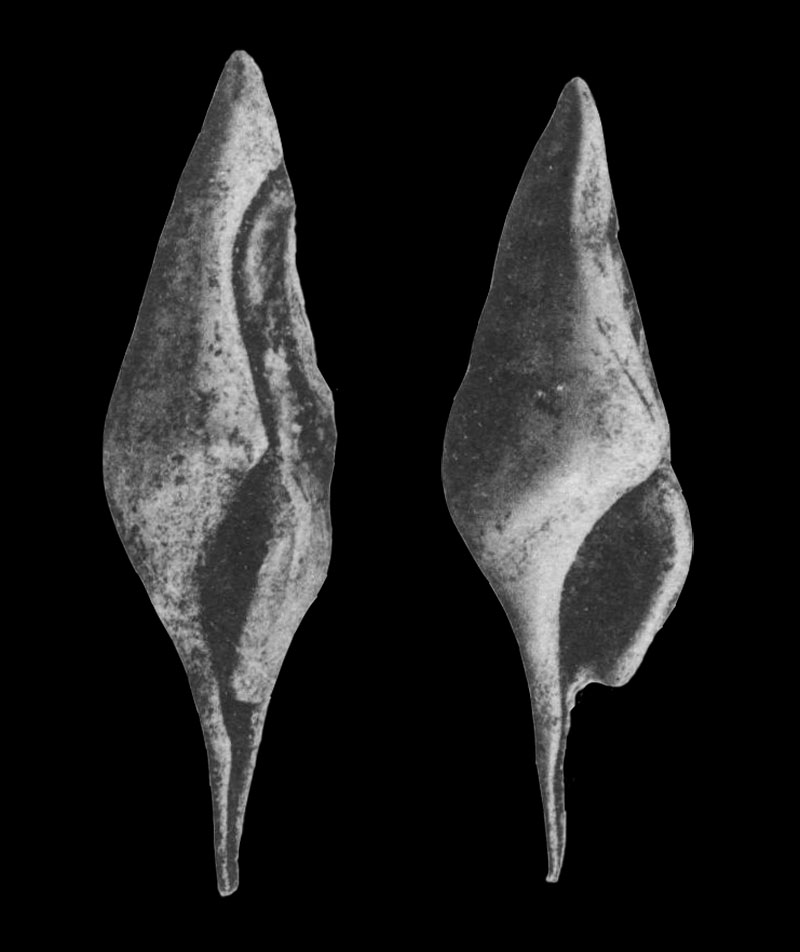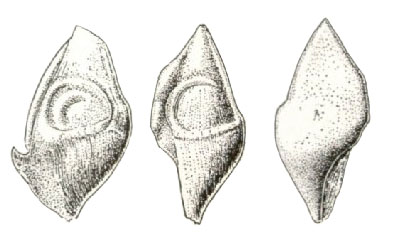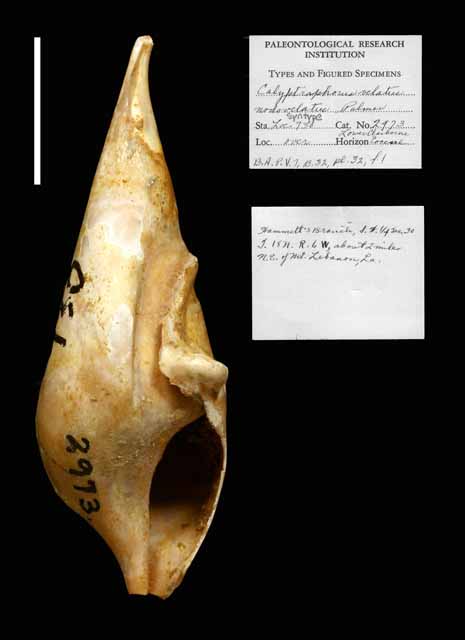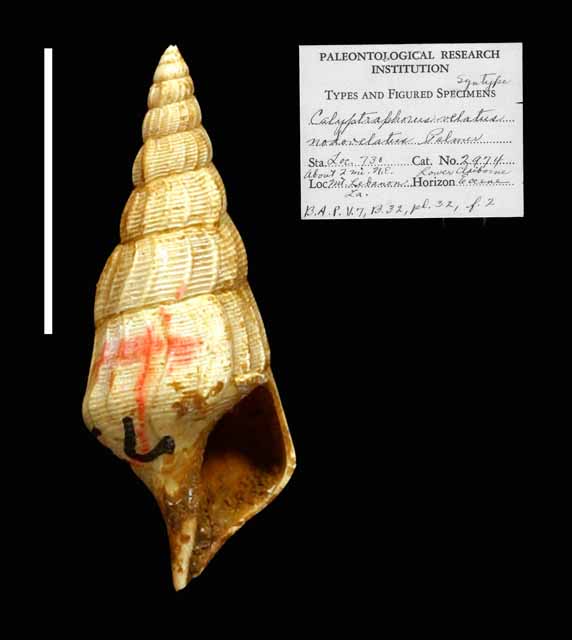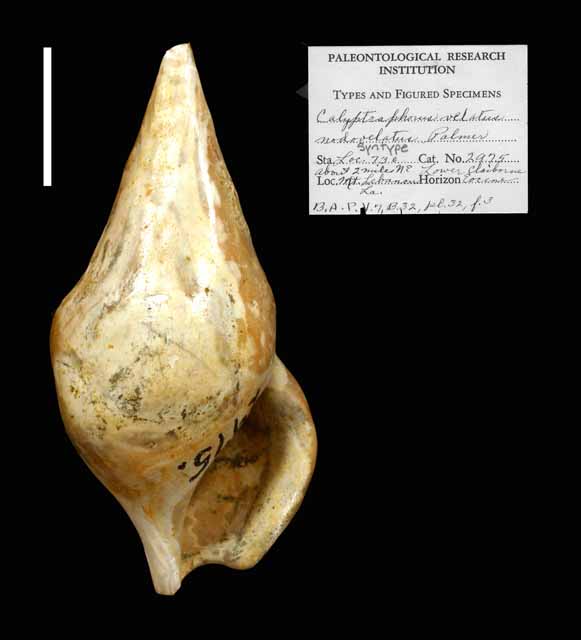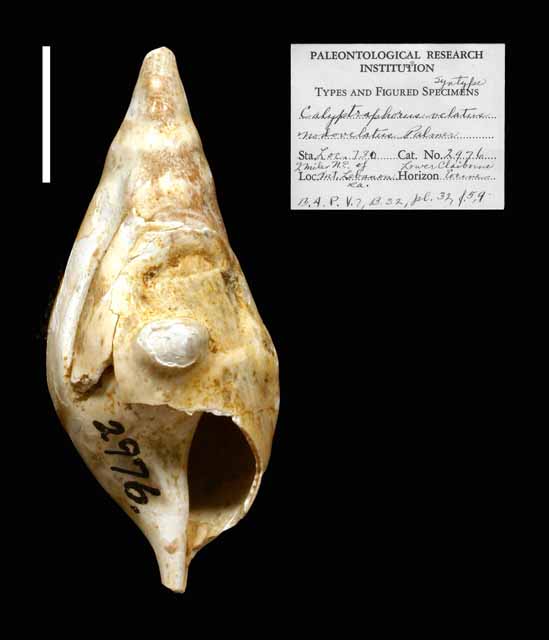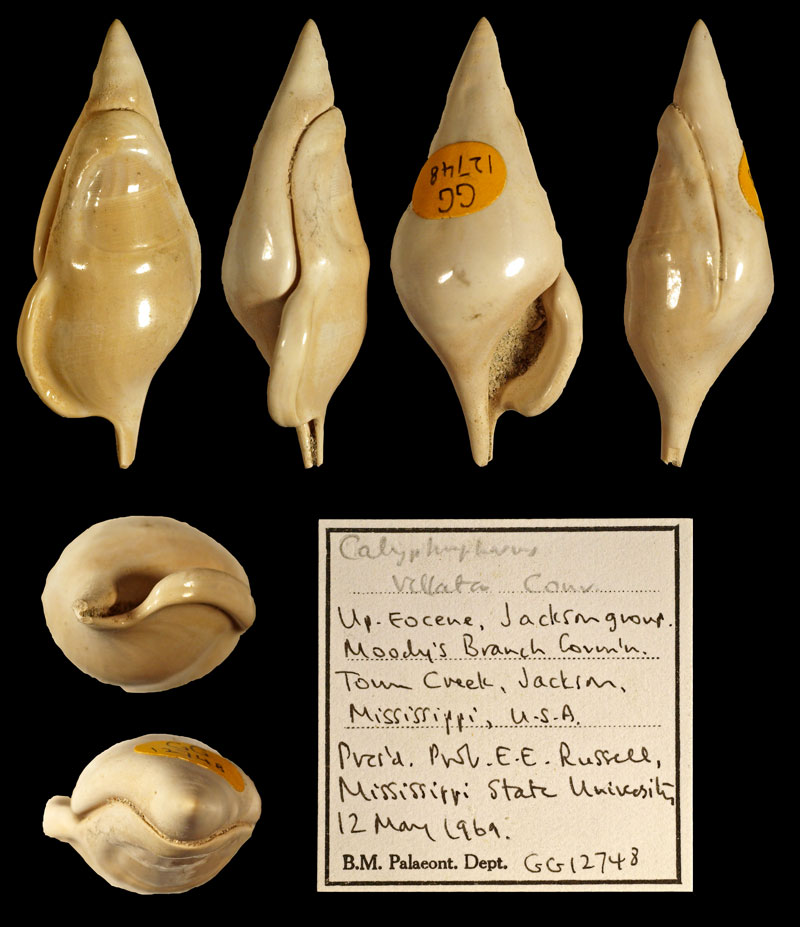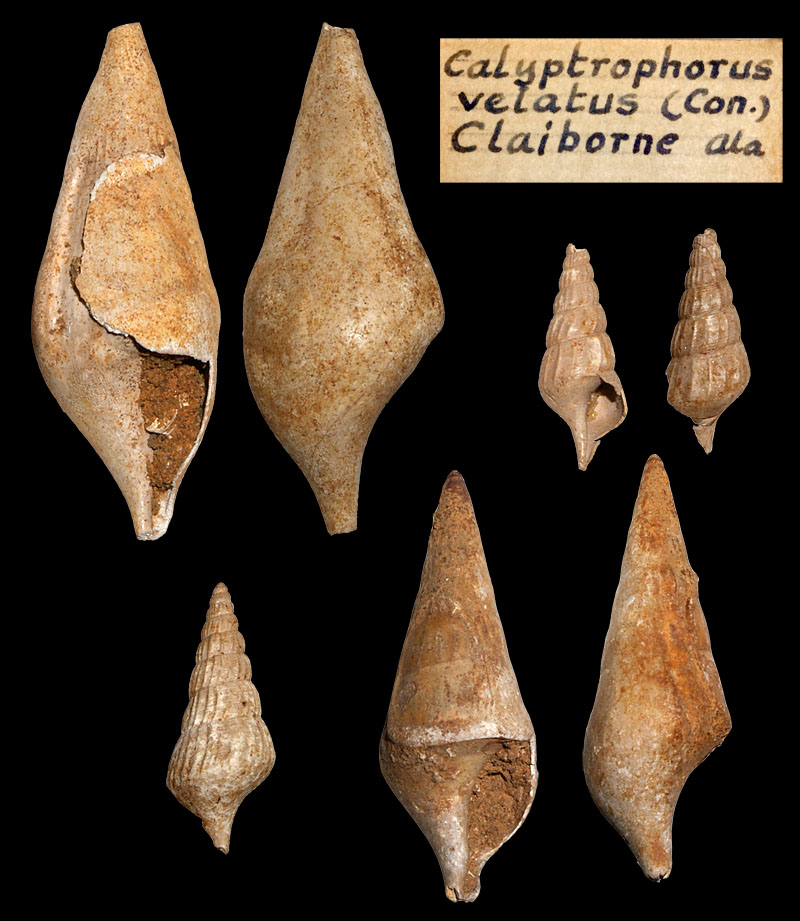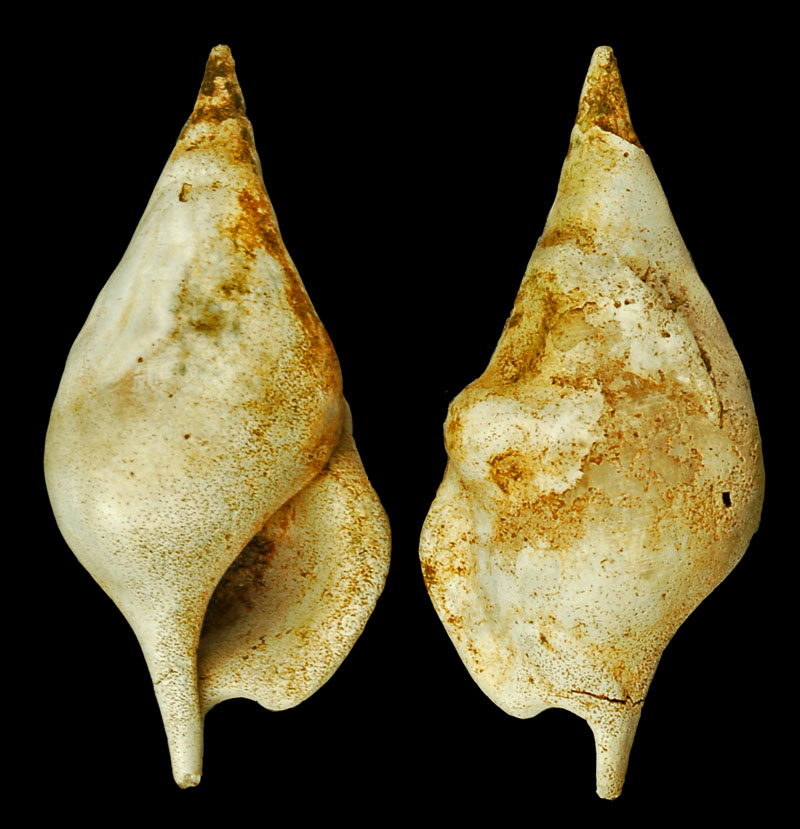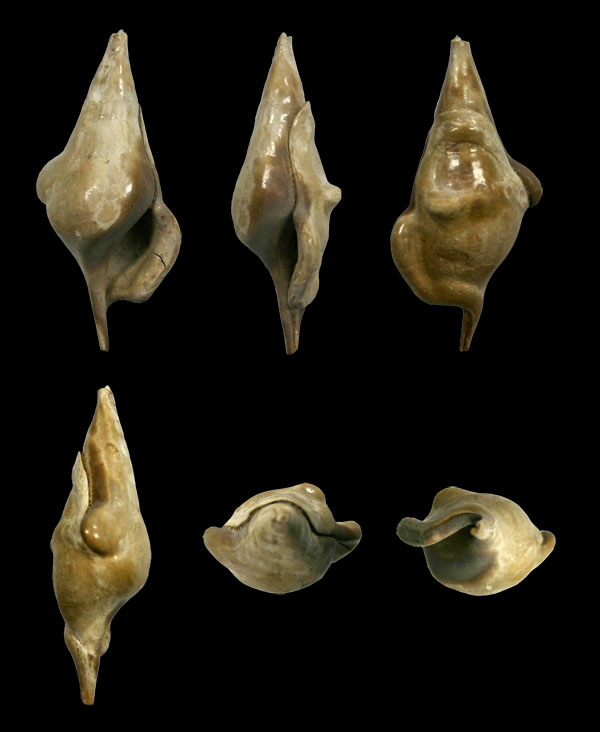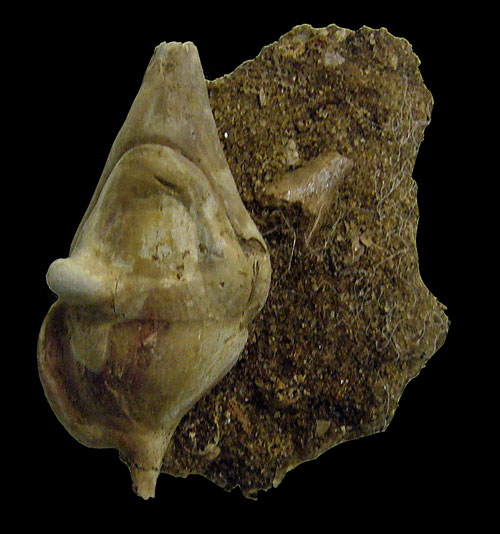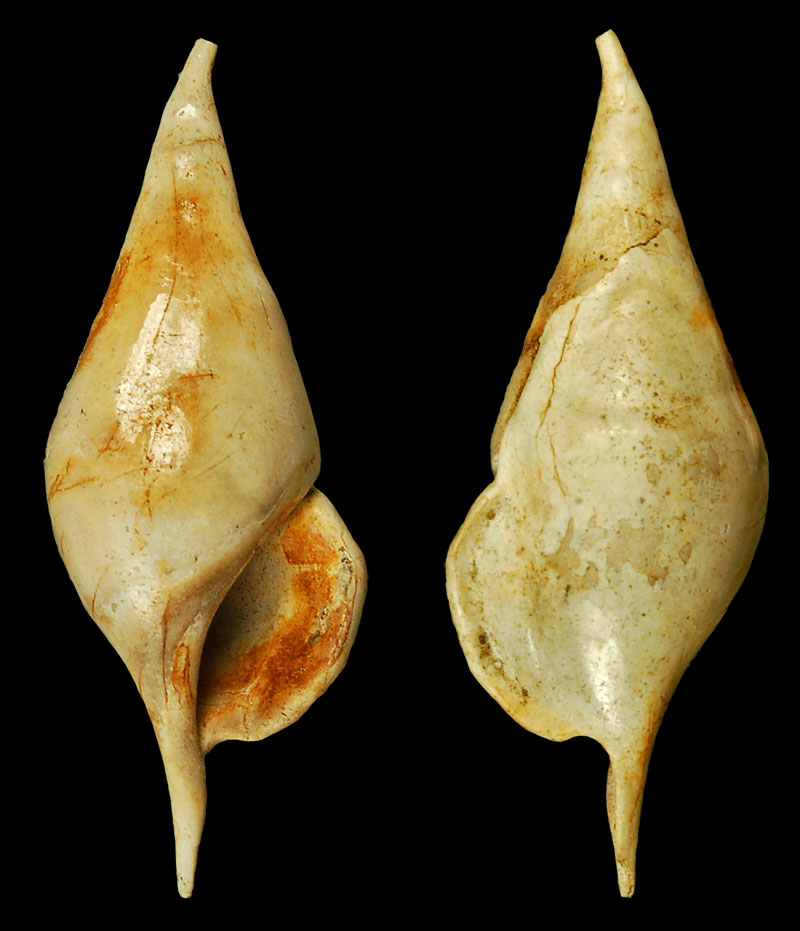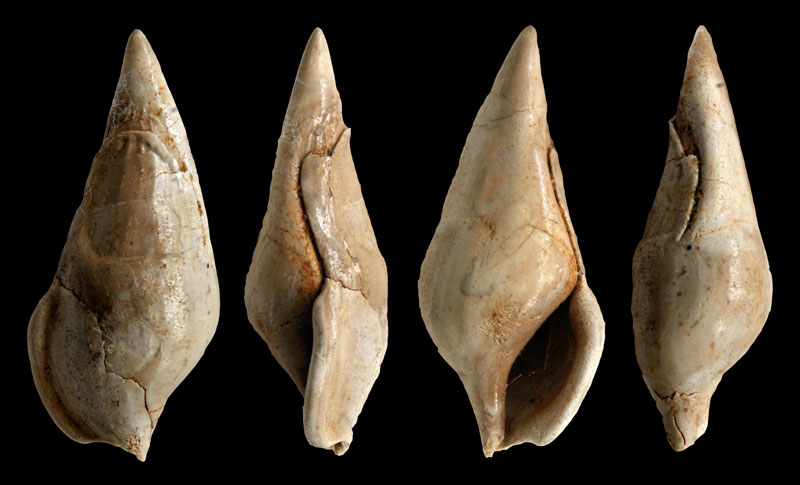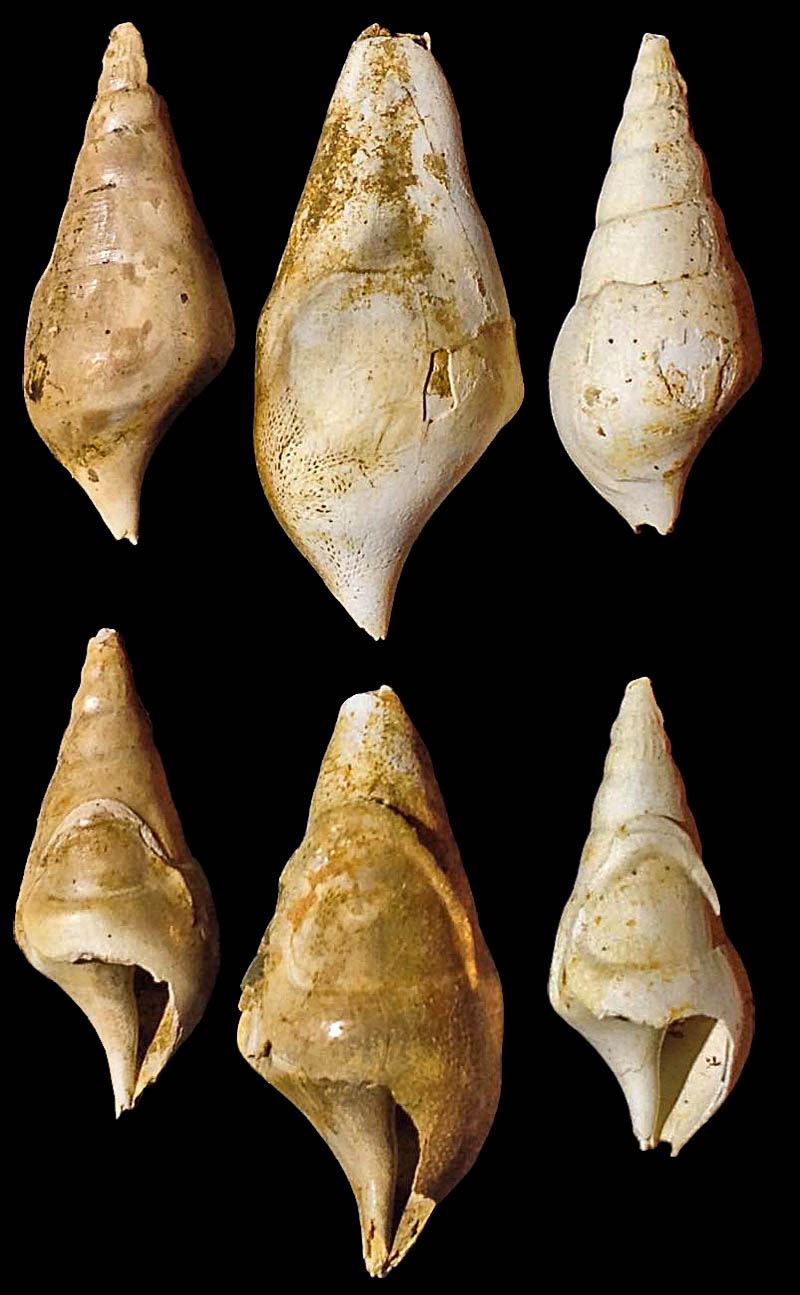Stromboidea
Original Description of Rostellaria velata by Conrad, 1833, p. 31:
- "Shell subfusiform, longitudinally ribbed and transversely striated, but often coated more or less with a smooth, polished calcareous deposit, bounded by a deep groove running upon the spire and returning towards the base: outer lip not expanded; margin thick and reflected."
Locus typicus: Claiborne, Monroe County, Alabama, USA
Stratum typicum: Gosport Sand, Bartonian, middle Eocene
Dimensions: "Length 1 1/2 inches."
History and Synonymy
- Rostellaria Lamarckii Lea, 1833:158, pl. 5, fig. 164
- Rostellaria (Calyptraphorus) quidest de Gregorio, 1890:115, pl. 10, fig. 1, 2a, b
1833
Description of Rostellaria Lamarckii by Lea, 1833, p. 158:
- "Shell fusiform, covered with longitudinal flexed ribs cut by numerous transverse striae, which in the adult are hidden, the whole surface being coated by a deposit; substance of the shell thick; spire elevated, acute at the apex; suture impressed, when coated as in the adult scarcely perceptible; whorls about twelve, convex in the young, scarcely perceptible through the coating of the adult; canal at the base short, above nearly erect, extending half way up the spire, where passing in a curve to the opposite side it descends about the same distance; mouth subovate, rather contracted; outer lip small, thin and edged below, above thick and recurved."
- Dimensions: "Length 2.2, Breadth .7, of an inch."
Rostellaria Lamarckii Lea, 1833, pl. V, fig. 164
1835
Description of Rostellaria velata by Conrad, 1835, p. 38:
- "Fusiform, with longitudinal curved ribs and spiral striae, but coated more or less with a smooth polished calcareous deposit, bounded by a deep groove running on the spire and returning towards the base; labrum not expanded; margin thick and reflected; beak and spire prolonged and attenuated."
- "Locality. Claiborne, Alab."
- "Syn. R. Lamarckii, Lea, con. p. 158, pl. 5, f. 164."
- "This curious species is very abundant. Young shells are destitute of the tunic and the margin of the labrum is thin and not reflected."
Rostellaria velata in Conrad, 1835, pl. 15, fig. 5
1854
Rostellaria vellata[sic] Conrad in Wailes, 1854, pl. XV, fig 7 a, b
1860
Calyptraphorus velatus Conrad, 1860, pl. XLVII, fig. 21
- Conrad, 1860 gives only the drawing, nothing else
1868
Calyptraphorus velatus in Gabb, 1868, pl. 13, fig. 9
1890
Description of Rostellaria (Calyptraphorus) velatus by De Gregorio, 1890, p. 114:
- "Juvenis: Testa elegantissima, potius fragilis, apici acuminata; primis tribus anfractibus laevigatis, caeteris 7 elegantissime axialiter costulatis, spiraliter dense lineariter funiculatis; costis tenuibus pliciformibus arcuatis; filis axialibus maxime minutis, funiculos clathrantibus; canali antieo erecto, tenui; labro externo fragili, acuto."
- "Adulta: Testa fusiformis, nitida, polita, strato calcareo laevigato per totum superficiem expanso; aliquibus anfractibus spirae vix tantum visibilibus; strato calcareo per dorsum in spatio subtriangulari subcarente; apertura ovali angusta, antica profunde arcuatim emarginata; labro externo calloso; rima postica angusta, profunda, postice usque ad 1/2 spirae protracta dorsoque reversa; rostro angusto, erecto, fragile."
Comment De Gregorio, 1890, p. 114:
- "Cette espèce se présente avec des formes différentes selon l'âge, de sorte qu'on pourrait croire qu'on aurait affaire avec plusieurs espèces. Je doute que la R. (Calyptraphorus) staminea Conr. se soit une d'elles. M. Conrad figura cette espèce dans son ouvrage «New Cret. Eoc. foss. Miss. Ala.», mais il ne la décrivit pas dans cet ouvrage."
Rostellaria (Calyptraphorus) velatus in De Gregorio, 1890, pl. 9, fig. 21 - 30
- "Pl. 9, f. 21-23 le même exempl. de trois côtés; — f. 24 exempl. pas ancore adulte; — f. 25-26 gross. jeune exempl.; f. 27 détail gross. — f. 28-29 * reprod. de Lea (Lamarki); — f. 30 * reprod. de Conrad."
Original Description of Rostellaria (Calyptraphorus) quidest by De Gregorio, 1890, p. 115:
- "Testa fusiformis, strato calcareo crasso, madreperlaceo, induta, latere aperturae plano-convexa; dorso in spatio a rima circumdato anfractibus paulo visibilibus; rima postice protracta usque ad dimidium spirae, inde antice reverso."
Comment De Gregorio, 1890, p. 115:
- "Ce n'est pas vraiment une espèce mais une forme intermédiaire entre Rostellaria (Calyptraphorus) trinodosa Conr. et velata Conr. Elle diffère de la trinodosa par l'extrèmité de la spire droite, par la forme plus lourde et par le défaut des trois noeuds elle diffère de la velata par l'épaisseur de la couche calcaire et par l'échancrure plus prolongée en arriere et plus remontante. En la référant à une des deux espèces, j'aurais dû les référer toutes les trois à la même espèce."
Rostellaria (Calyptraphorus) quidest De Greggorio, 1890, pl. 10, fig. 1, 2a, 2b
1894
Aldrich, 1894 described Rostellaria (C.) velatus var. compressa
1904
Rostellaria (Calyptrophorus) velata in Cossmann, 1904, pl. III, fig. 1, 2
1912
Calyptraphorus velatus var. compressus in Maury, 1912, pl. XII, fig. 8, 9, 10
1937
Calyptrophorus velatus nodovelatus Palmer, 1937; Syntype; Cook Mountain Formation, middle Eocene; Hammett's Branch, Bienville Parish (County), Louisiana, USA; Coll. Paleontological Research Institution no. PRI 2973; Image reproduced courtesy of the Paleontological Research Institution
Calyptrophorus velatus nodovelatus Palmer, 1937; Syntype;Cook Mountain Formation, upper Claiborne Group, middle Eocene; Wautubbee, Clark County, Mississippi, USA; Coll. Paleontological Research Institution no. PRI 2974; Image reproduced courtesy of the Paleontological Research Institution
Calyptrophorus velatus nodovelatus Palmer, 1937; Syntype; Cook Mountain Formation, upper Claiborne Group, middle Eocene; Hammett's Branch, Bienville Parish (County), Louisiana, USA; Coll. Paleontological Research Institution no. PRI 2975; Image reproduced courtesy of the Paleontological Research Institution
Calyptrophorus velatus nodovelatus Palmer, 1937; Syntype; Cook Mountain Formation, upper Claiborne Group, middle Eocene; Hammett's Branch, Bienville Parish (County), Louisiana, USA; Coll. Paleontological Research Institution no. PRI 2976; Image reproduced courtesy of the Paleontological Research Institution
Specimens from institutional collections
Calyptraphorus velata (Conrad, 1833); upper Eocene; Town Creek, Jackson, Hinds County, Mississippi, USA; Coll. BM(NH) no. GG 12748; Copyright BM(NH)
Calyptraphorus velatus (Conrad, 1833); Claiborne, Alabama, USA; Coll. BM(NH), Copyright BM(NH)
Specimens from private collections
Calyptraphorus velatus nodovelatus Palmer, 1937; Upper Lisbon Formation, Lower Upper Eocene (Bartonian); Near Puss Cuss Creek, Choctaw County, Alabama USA; 40 mm; 1983; Coll. Michael Reagin MR 3617-465
Calyptrophorus velatus nodovelatus Palmer, 1937; Lisbon Formation, Claiborne Stage, middle Eocene; Barrytown, Choctaw County, Alabama, USA; Coll. UW2309
Calyptrophorus velatus nodovelatus Palmer, 1937; Lisbon Formation, Claiborne Stage, middle Eocene; South of Souwilpa Creek on CR 21, ACh-8, Barrytown, Choctaw County, Alabama, USA; 31,6 mm; Coll. Aart Dekkers no. STR9108
Calyptraphorus velatus (Conrad, 1833); Gosport Sand, Lower Upper Eocene (Bartonian); Little Stave Creek, Clarke County, Alabama, USA; 50 mm; 1983; Coll. Michael Reagin MR 1909-120
Calyptraphorus velatus (Conrad, 1833); Moodys Branch Formation, Jackson Stage, Eocene; Jackson, Mississippi, USA; Coll. Han Stoutjesdijk no. 4995; Ex-coll. Tera Smith
Calyptraphorus velatus (Conrad, 1833); Weches formation, Claiborne Group, middle Eocene; Nacogdoches County, Texas, USA; m: 27 mm; Coll. Joshua Hanley
References:
- Aldrich, 1894. Geol. Surv. Alabama, p. 244, pl. 12, figs. 2, 2a, 2b
- Aldrich, 1921
- Conrad, T.A. 1832-1833. Fossil shells of the Tertiary formations of North America, illustrated by figures drawn on stone, from nature. vol. 1 (in four parts). [1(1): i-viii, 9-20, pls. 1-6; 2: 21-28, pls. 7-14, 1832: 1(3): 29-38, no plates; 4:39-46, no plates, 1833; republished by G.D. Harris, 1893, with additional plates 19-20; reprinted 1963: Paleontological Research Institution, Ithaca, New York]
- Conrad, 1860
- I. Lea, 1833. Contributions to Geology; Philadelphia, Carey, Lea & Blanchard; pp. 1-227, pls. I-VI. URL
- Palmer, K.V.W., 1937: The Claibornian Scaphopoda, Gastropoda and Dibranchiate Cephalopoda of the Southern United States, Bulletins of American Paleontology 7(32), pl. 32, fig. 5,9

